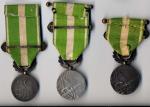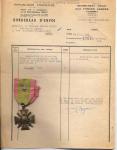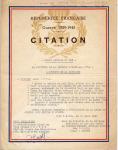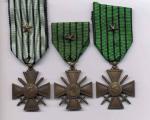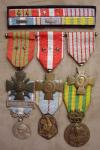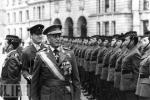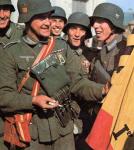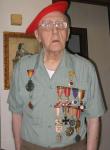-
Posts
2,284 -
Joined
-
Last visited
-
Days Won
6
Content Type
Profiles
Forums
Blogs
Gallery
Events
Store
Everything posted by PKeating
-
Instituted on 22.7.1909 for the pacification of Morocco, these medals were struck in silver - some sources state silver-plated bronze but mine all bear silver marks - and issued with four clasps in the 'oriental' style: CASABLANCA, OUDJA, MAROC and HAUT-GUIR. No awards were made after 20.7.1912. As you can see, one of the medals has been replaced by a civil service medal to one F Douley in 1952, perhaps by the veteran himself, reasoning after losing the medallion part that one medal obverse bearing the Marianne was much like another. PK
-
Jean Boisset's Croix de Guerre and his citation was eventually sent to Colonel Romans-Petit at the Maison du Maquis at 5 rue Faubourg Poissoni?re, Paris with the medal on 12.5.1950 for relay to Jean Boisset. This is the folder protecting the citation, which is on better quality paper. On the citation itself, Colonel Romans Petit is also noted as at the Maison du Maquis, 83 rue de la Faisanderie, Paris 16, with a later annotation for the change of address. The medal is an exceptionally fine striking and an ensemble like this is extremely rarely seen. More later, unless someone here wishes to contribute any remarks about the Semnoz FFI, Colonel Romans Petit of the Ain FFI and that aspect of the war in France... It was thanks to Chris Boonzaier that I got this. I was bidding from my hospital bed on an iPhone with the nurses jumping up and down over cell use in the intensive care unit... PK
-
-

Bundesrepublik The new "Iron Cross"
PKeating replied to webr55's topic in Germany: Post 1945: Bundesrepublik & DDR
Fascinating! I didn't know that. Thanks. I still don't much like the colour combination, though. However, checking the sources, I see that the black, white and red flag was also used, albeit in a limited way. PK -

Bundesrepublik The new "Iron Cross"
PKeating replied to webr55's topic in Germany: Post 1945: Bundesrepublik & DDR
Despite what some people like to imagine, the reputation of the Iron Cross is neither "tarnished" nor "shot" as a result of WW2. Were that the case, the Bundeswehr would not use it on their vehicles and aircraft. The vast majority of recipients of various classes of the Iron Cross 1939 received their awards for bona fide acts of valour. Were the Iron Cross 1939 considered tarnished, there'd have been no 1957 issue and it wouldn't have been proudly worn by many high-ranking Bundeswehr and NATO officers in the 1960s and 1970s. Nor would it have been seen on Spanish chests at Wellington Barracks in the 1980s. As for the Knight's Cross, the dwindling band of holders are held in high esteem in Germany, Austria and other countries and not just by people some might write off as far right nutters. The Knight's Cross of the Iron Cross 1939 reflected what was left of the socialist mores in National Socialist philosophy, representing as it did a break with the old class-based system of the Pour-le-M?rite for commissioned ranks and the Goldenes Milit?r-Verdienstkreuz for other ranks, just as the Waffen-SS represented a new kind of meritocratic armed force. Of course, one has to try to see through the retrospective PC hyperbole and rhetoric to understand what all of this meant to ordinary fellows from working class backgrounds in the 1930s and early 1940s. Rick is right in reminding us that the early Prussian Iron Cross was only awarded for wars against France in 1813 and 1870. Some opine that it is a decoration that can only be instituted if Germany is at war and, moreover, at war in defence of the homeland. This was untrue in 1914 and 1939. Germany awarded the 1914 and 1939 Iron Cross for combat that had little to do with national defence and was often extremely far away from the homeland. That Germany is "not at war" has more to do with the reluctance of European leaders to use the W word than with the reality of the situation. The Western nations are most assuredly at war against various enemies on several fronts. Germany is part of that alliance and should stop pussyfooting around the issue and take a reality check. This medal is an abomination. Even some of the most culturally challenged Communist countries managed to come with better-looking bling than this. It wouldn't be so bad were the borders in enamel. But this evokes those late war Nazi awards and party badges, with their painted backgrounds. Awful! They should just remanufacture an 1813-style Iron Cross, with the 1813 reverse and the plain obverse, with the Imperial era ribbons for military and civil awards and have done with it. That way, there'd be no valid justification for the usual suspects to start yapping about Nazi militarism. For that matter, they should also abolish that horrible flag with its migraine-inducing colours and readopt the old black, white and red colours, which were also flown during the Weimar period. Terrible things were done by Germans and their allies in WW2 but we also did some pretty questionable things, such as the terror bombing of German cities, the nuking of Japan and the various atrocities perpetuated in the attempts to reinstate the imperialist status quo throughout Africa and Asia after the war. Germany should probably also reinstitute the military Pour-le-M?rite but for all ranks, as well as the Wound Badge and the Infantry Assault Badge and some of the other very classy awards of the WW1 and WW2 periods. PK -

A Very Unusual Group
PKeating replied to Riley1965's topic in Great Britain: Orders, Gallantry, Campaign Medals
You've done very there. It's a wonderful group. It's a fair bet that she served with The St John's Ambulance Brigade during WW2. They supported the official emergency services and still do. She might have driven an ambulance during the Blitz or something like that. Very researchable. PK -
You were right to include it. We sometimes forget those who were or are left behind in our desire to honour those who fell. Quant au groupement, cher ami, je regrette que je ne peux rien vous dire au niveau de sa valeur, qui devrait ?tre importante, mais je n'ai jamais vu un tel groupement, sauf, comme vous dites, quelques exemplaires aux officiers purement britanniques. Mais le Canada fran?ais? Jamais! Je suppose que m?me si l'Enseigne Jean-Baptiste Levereault de Langis de Montegron dit ?Langy? desapprouvait politiquement les Qu?becois qui luttait pour les anglais, il les aurait bien acceuilli au Valhalla en tant que guerrier franco-canadien! You are looking at an insurance value somewhere past five figures in Sterling, let alone Canadian dollars. PK
-
Perhaps the depression in Ireland will influence things. What use is a shopping centre when everyone is too broke to go shopping? There again, the powers-that-be may be scared of being seen to do anything that hinders any construction project, given that industry's parlous state in Ireland since before the 'credit crunch'. If the developer is a powerful local with friends in high places and on the golf course, the entire Citizens Army and IRA risen from the dead with well-oiled weapons won't save Moore Street and its environs. Good old Irish venality will win the day because most of our people are hooked on easy money, sad though it be to say so. Thanks for the tip about the exhibition, though. I'll be in Dublin that weekend. PK
-

SAS / Parachute Regiment
PKeating replied to ukok's topic in Great Britain: Militaria: Badges, Uniforms & Equipment
Never saw anything like that worn by a Para nor by any of the SAS men I encountered. I did meet one SAS man on his jump course at Brize Norton one time who was wearing a Kangol beret but he was Signals-badged. The others wore private-purchase Victor-style berets similar in all but colour to the berets worn by 99.9% of Paras. Never saw any kit with special stamps or labels. PK -
A pleasure, Tim. Expanding on the scrutiny to which recipients' awards were submitted after the Liberation, it should be noted that the Vichy government also subjected awards to scrutiny after the armistice as a result of veterans' outrage over the liberal awards by some French generals, who had even suggested that any French soldier who had not surrendered when the armistice was proposed should receive the Croix de Guerre. The pro-Vichy L?gion fran?aise des Combattants, one of the paramilitary veterans' associations set up after the armistice, organised a court of honour comprising veterans and serving officers or, rather, soon-to-be-demobilised officers. To tackle the problem, which was seen as a devaluation of the award, the court proposed the abolition of the 1939 CdG and the introduction of a new type, this being the 1939-1940 CdG. Anyone wishing to wear a CdG awarded between the end of the Phony War or Sitzkrieg on 10.5.1940 and the end of hostilities had to apply for the new version, thereby submitting himself to scrutiny. Wearing the 1939 cross was a punishable offence. So, in conclusion, the 1939-1940 CdG was not as 'political' as one might presume. It was quite a radical solution to the perceived problem of relaxed award criteria. Many veterans of the War of 1939-1940 who joined the LVF or branches of the Wehrmacht proper wore their 1939-1940 CdG on their German tunics with pride. If some Germans were offended by this or by the sight of WW1 Croix de Guerre and other medals, they had to grit their teeth and bear it because it was all part of the grand charade of Franco-German 'Cooperation'. Now, where is Ren? Chavez, who could tell us about the Giraud crosses and perhaps show us one from his collection. PK
-
And now for something slightly different but remaining within the Vichy theme. The crosses on the top are the Croix de Guerre des Th?atres d'Op?rations Exterieurs - Croix de Guerre TOE - for overseas campaigns. Top left is a standard French-made example from the early WW2 period. Top right is an North African-produced example and awarded to a Senior NCO in the 2? R?giment des Tirailleurs Morocains - literally "Moorish Riflemen", a colonial infantry regiment from North Africa. The interesting thing about this is that the 2? RTM was pro-Vichy and was dissolved in 1944. So this is can be said to be a Vichy Croix de Guerre TOE. Note the differences between the Marianne heads. The Marianne on the North African-made cross differs from the French Metropolitan-produced cross. This type of head is sometimes described as an indication of African manufacture. As a footnote, the 2? RTM was reformed in 1947 and sent off to Indo-China. The winner of the this cross went with them. I have some of his stuff, from his grandson, including his Drago-made cigarette lighter with the regimental badge in enamels on one side and the map of Indo-China on the other. The original "Vietnam lighter"! Bottom left in the above picture is the Republican 1939-issue Croix de Guerre as awarded during the 1939/40 campaign in France, before the armistice. This type, and the 1939-1945 type produced the Paris Mint are really the only official WW2 CdG. Next to it, you can see the round '3' "big date" Vichy-issue cross to which I referred earlier. It hangs from a Republican ribbon, indicating that the recipient's entitlement was upheld by after the Liberation.
-
Vichy Croix de Guerre. Left: 1939-1940 "small date" cross with the rare variation ribbon. Centre: Vichy's only official Croix de Guerre, dated 1944. Right: 1939-1940 "small date" cross with the classic ribbon. The black and green ribbon is sometimes said to be a subtle reference to the ribbon of the medal for the Franco-Prussian War of 1870-1871 and France's defeat, in other words, a subtle display of national mourning. As for the Etat Fran?ais CdG, it was instituted early in 1944 by the P?tain government. Being a purely military award, members of the Milice and other paramilitary and security organisations were ineligible. By that stage, the only soldiers eligible for this award were members of P?tain's personal bodyguard, the Groupe de Protection, and the 1st Regiment of France, a purely Vichy unit raised in 1943 when P?tain envisaged rebuilding the French Army, which angered Hitler. The 1944 Vichy Croix de Guerre was awarded for combat against partisans of various resistance groups and their SAS and SOE comrades. According to contacts here in Paris, there are several recipients known to be still alive. It is believed that no more than a hundred, perhaps far less, were awarded before the eventual collapse of the Vichy regime in August 1944 and the flight to Germany, making this cross as rare as or perhaps even rarer than the fabled Croix de Guerre L?gionnaire, instituted in January 1942 for members of the L?gion des Volontaires Fran?ais contre le Bolchevisme fighting on the Eastern Front, which, although approved by the Vichy government, was not an official award, which is why those lovely examples one sees bearing the hallmarks of the Paris Mint are to be avoided. The LVF cross was privately commissioned and produced by the firm of Arthus Bertrand, who, according to a friend who happens to be a scion of the family, still have the dies, although they are in a very deep, dark place indeed and highly unlikely ever to be put to use again, unlike various German dies. The London-based French Committee for National Liberation (Comit? fran?ais de la Lib?ration Nationale) passed a motion outlawing Vichy awards on 7.1.1944, actively implementing it as soon as Paris was liberated in August 1944. The Etat Fran?ais CdG, the LVF CdG and the various other unofficial CdG produced by General Giraud and General Juin were all abolished, along with other awards like the Vichy Croix du Combattant, the Ordre National du Travail and so on and so forth. As you can see, many of those in possession of a 1939-1940 cross simply changed the ribbon. PK
-
There is another type as well, which appears to have been struck on the same dies as the cross on the right. The central medallion with the larger dates is similar but has a rounded '3'. These "large date" crosses are said by some students of the subject to have been produced in French Africa, which was under Vichy control at the time of the abolition of the 1939 CdG and the introduction of the 1939-1940 CdG. The 1939-1940 CdG, along with the 1939-1940 Croix du Combattant, was part of general policy reflecting the official line that the war between France and Germany was over. The cross on the right is scarcer than the type on the left with the normal, small dates. The Vichy government produced one official CdG during the war: this was the type with the single date '1944' and the Francisque instead of the Marianne on the obverse, with the legend "Etat Fran?ais". It is important to note that a veteran wearing the Vichy-issue CdG was not necessarily pro-Vichy. I have a cross in my collection to a motorcycle scout with an artillery unit who was awarded it on 27.6.1940, several days after the armistice. It is a classic Vichy cross like the one on the left, with the small dates, but on a "Republican" ribbon that seems to be of British manufacture. The citation is divisional, meaning that the Cannonier motocyclist d'?lite Pierre Ursault would have had a silver star on his ribbon. He may well have worn a silver star on the Vichy-approved ribbon but when he framed his document and cross with a new "Republican" ribbon, he obviously didn't have the star to hand. Such citations were vetted after the Liberation to weed out any CdG handed out like candies by obliging commanders to undeserving cases as France fell apart in the summer of 1940. Pierre Ursault evidently satisfied the scrutineers and deservedly so. PK
-
Here is another EXTREME ORIENT clasp on another small ?Free French-issue? Colonial Medal, part of a pair with a 1939-1945 War Medal with the clasps FRANCE and ENGAG? VOLONTAIRE. They are in a period frame with a Colonial Medal certificate issued in Saigon in 1947 to Sergent Roger Loncle of the French Air Force?s Compagnie de Garde de l?Air 595. The C.G.A 595 was tasked with securing Tan Son Nhut airport, near Saigon, after the Japanese surrender in August 1945. French armed forces had co-existed uneasily with the Japanese armed forces during their occupation of Indo-China and there would have been a contingent of French guards stationed at Tan Son Nhut. This unit might have been the Compagnie de Police S?curit? Tan Son Nhut. Some sources say that the C.P.S. Tan Son Nhut was redesignated C.G.A 595bis, then C.G.A 595 and, later, C.G.A 31/191. I am inclined to believe that C.G.A 595 was the unit designation of the 150-strong contingent airlifted to Tan Son Nhut in August 1945 and that some of these men were drawn from Free French Forces in Europe. This would explain the presence of the FRANCE clasp on Loncle?s War Medal. The ENGAG? VOLONTAIRE clasp indicates that Roger Loncle volunteered, either for the regular French forces in 1939 or for General de Gaulle's Free French Forces after the armistice with Germany. Loncle could probably have gotten away with sticking an Indochine clasp on his 1939-1945 War Medal but he evidently didn't bother. To digress for a few moments, the document itself is interesting as it is signed by General Raoul Salan, Commander-in-Chief of French forces in Indo-China in the early stages of the First Indo-China War. Salan would later gain notoriety for his r?le in, amongst other things, the attempted coup d??tat against President de Gaulle in 1961. The rebels took control of Algiers and other major centres but the putsch des g?n?raux, as it is also known, was suppressed before they could carry out their planned airborne assault on central Paris. Along with others, Salan was charged with treason and condemned to death in absentia. On the run, he and others founded the OAS or Organisation de l?Arm?e Secr?te, best-known to those unfamiliar with postwar French history through the opening scenes of Day of the Jackal, when OAS men spray de Gaulle?s Citro?n DS with machinegun fire. Salan was captured in 1962 but his sentence was commuted to life imprisonment. He and other officers were amnestied in 1968 and released. In 1982, their ranks and honours were restored in a move by the socialist Mitterand government that enraged many of France?s committed lefties. However, Mitterand himself had a chequered past, as one of the relatively few Vichy officials awarded the Ordre de la Francisque by P?tain before he reinvented himself as a R?sistance hero. French politics and history are nothing if not complicated? PK
-
An Indochine clasp was authorised for the Colonial Medal but it was of the so-called 'oriental' design rather than rectangular, like the Extreme-Orient clasp in the following photograph. Some veterans who spent the war in Indo-China in an uneasy co-existence with the Japanese or who participated in combat against the Japanese at the very end of the war made a point of attaching Indo-China bars to their 1939-1945 War Medals, as the ribbon bar in the photograph shows. The Extreme-Orient clasp, seen on this so-called Free French-type Colonial Medal, of a smaller size than the normal medal, covered French personnel who had seen service in the Far East during WW2 but some veterans, particularly of the battles at the end, felt they deserved special recognition, hence the anomaly. As for the clasps on the Indo-China Medal, I can see a veteran of Dien Bien Phu sticking an official clasp on his medal but the Indochine clasp strikes me as redundant, for obvious reasons. PK
-

Question re: Blue Division & Spanish Army protocol
PKeating replied to Obergefreiter's topic in Spain
You brought the Azad Hind people up, Ed. In fact, on reflection, it is relevant to this discussion. We can certainly discuss it elsewhere on this forum. It is an interesting subject but you're stretching things a bit in your effort compare them to the Blue Division. There is no comparison to be made. Nor is there really any comparison to be made between Chandra Bose and Francisco Franco. Chandra Bose would have welcomed help from Hitler in ending British rule in India but Franco not only managed to obtain substantial help from Hitler but also managed to avoid the mistake Mussolini made in becoming too entangled with the F?hrer. You mention the Azad Hind Fauj or Indian National Army and Bose but which Bose do you mean? Rash Bose or Chandra Bose? If you are referring to the AHF as formed by the Indian expatriate Rash Bose, living in Tokyo, and later developed under the guidance of Chandra Bose and the Provisional Government of Free India, I would be more inclined to compare them to Vlasov's Russian Liberation Army (POA). The Indian units formed by the Germans might have had the approval of the PGNI but unlike their INA counterparts in the Far East, they never saw action. The INA, on the other hand, fought alongside the Japanese Imperial Army in Burma and the east of India, near Imphal. Would former Indian Army other ranks and NCOs have worn medals or medal ribbons earned in British service on their INA or Wehrmacht uniforms? Again, given their new-found antipathy to Britain, they were as likely to do so as POA soldiers were likely to wear Soviet awards earned in the service of Moscow. Unlike the men of the Divisi?n Azul, L?gion Volontaire Fran?aise and certain Waffen-SS foreign volunteer units, whose service in German uniform against Bolshevism was perfectly legitimate and legal, formations like the INA and the POA could not claim the same legitimacy and legality, no matter how morally justified they might have felt in turning their coats. If anyone has a photograph of an Indian in Wehrmacht uniform or INA service wearing British medal ribbons, I would love to see it. Same applies to POA men and Soviet decorations. Mind you, I believe that some older POA men put their old Tsarist medals on, subject to availability. PK -

Question re: Blue Division & Spanish Army protocol
PKeating replied to Obergefreiter's topic in Spain
One should never fall into the trap of underestimating Francisco Franco. But let's not get into that discussion here as GMIC is not the place for it and I doubt if our viewpoints on that score are reconcilable. Back on topic: here is a great shot of Lieutenant General Don Jose Gabeiras Monyero inspecting the 1st Battalion 2nd King Edward VII Own Gurkha Rifles at the Ministry of Defence in London on 30.10.1979. Note the Winter War Medal in third position on his medal bar. Gabieras would remain loyal to the young King Ju?n Carlos during the F-23 coup d'?tat, popularly known as the Tejero Putsch in February 1981. Anyway, I think this image provides a fairly conclusive answer to the topical question. This senior member of the Spanish General Staff representing his King and his nation four years after the Caudillo's death would have been observing protocol to the most minute degree. This confirms Rick's earlier post: had Gabieras received the Iron Cross 2nd Class, he would probably have worn it just after his Military Merit Cross, in front of the Civil War medal. Image ? Steve Burton/Getty Images -

Question re: Blue Division & Spanish Army protocol
PKeating replied to Obergefreiter's topic in Spain
?Viva la muerte...abajo inteligencia!: a young soldier of the Blue Division with the Falange badge and a Luftwaffe 'gull' on his ski-cap. At least these men had a valid reason to be in German uniform, unlike the Azad Hind renegades, for instance, who were never committed to battle, even when the Germans were really scraping the barrel. A further point of interest is the Portuguese contingent within the Blue Division. PK -

Question re: Blue Division & Spanish Army protocol
PKeating replied to Obergefreiter's topic in Spain
-

Question re: Blue Division & Spanish Army protocol
PKeating replied to Obergefreiter's topic in Spain
They were as much a part of the Wehrmacht as the Condor Legion was a part of the Spanish armed forces or, rather, that element of the Spanish armed forces under Franco and his comrades who instigated the revolt in 1936. The Condor Legion wore Spanish uniforms. Even when they paraded through Berlin in 1939 to celebrate the victory, they wore an approximation of the uniforms worn in Spain, using Reichsarbeitsdienst uniforms with their Spanish-based insignia and their Spanish awards. P?rez is wearing the 'home' uniform of the Divisi?n Azul as the wearing of German uniforms in neutral Spain would have been problematic. The uniform comprised the falangista blue shirt, the khaki trousers of the Spanish Foreign Legion - of which the Generalissimo had long been an officer - and the Carlist red beret. He looks just as he would have looked - age and a few medals apart - on leave from the Eastern Front in 1944. However, he would have taken the train back to his unit in Wehrmacht uniform. Yes, they were part of Wehrmacht but they were also an officially recognised Spanish military formation. They were in a similar position to the LVF, which was also part of the Wehrmacht but had French dress and walking-out uniforms in addition to their German kit. The sole difference was that the French government of the day had formed an alliance with Berlin and was therefore not a neutral state. P?rez wears the German-issued Division Espa?ola medal, which we call The Blue Division Medal, as well as the Spanish-issued award comprising the Spanish eagle with the 1939 Iron Cross motif. He also wears his EK2 and his Winter War Medal. PK -

Question re: Blue Division & Spanish Army protocol
PKeating replied to Obergefreiter's topic in Spain
My recollection is of the Iron Cross 2nd Class and other German decorations like the War Service Cross worn at the end of the medal bars by officers in dress uniform. I don't recall ever seeing any 1957-type reissues. They wore the German medals as they were issued, with the swastika. Recipients of the EK1 and other pinback awards wore them as-issued, in the same manner as German personnel. Link broken - see below The highly decorated Civil War and Eastern Front veteran Juan Luis Pacheco P?rez, who served with the Spanish Foreign Legion and the Blue Division. He died this year aged 90. P?rez won four Crosses of Military Merit as well as a host of other bravery awards and the EK2. He seems to be wearing Spanish-made examples of his German awards. Non-commissioned veterans attended rallies, reunions and other ceremonial events with their medals as-issued. There were also a couple of Spanish medal firms producing locally-made versions of German medals for veterans, which were not terribly well-made by comparison with most Spanish awards. I have a few, including, interestingly enough, an Eagle Order. Over 18,000 volunteers served in the Divisi?n Azul so there was a market for the suppliers. According to some sources, Spanish volunteers in the struggle against Bolshevism won 2,359 EK2, 2,216 KVK2 and 138 EK1. There were also two RK, one with Oakleaves, and two DKiG. They received the Blue Division Medal but I certainly recall some of the veterans wearing the Winter War Medal, signifying service in that first winter with Armee Gruppe Mitte and then Armee Gruppe Nord. Almost 5,000 Spaniards lost their lives in German uniform, with around 8,500 wounded. By the time Spain joined NATO in 1982, there were no serving veterans of the Blue Division in the Spanish armed forces, although there were some reserve officers who turned up to events in dress uniform from time to time. I wonder if any of them ever attended any events or soir?es alongside German officials or at the German embassy in Madrid wearing their 1939 pattern awards. That said, many of them were keeping low profiles at the time because of their involvement in the so-called Tejero Putsch in February 1981. However, others showed themselves loyal to the King. As I said, not all of them were fascists. There were even former Republicans, trying to curry favour with the new government. More than 3,000 declined to come home when General Franco issued the recall order in 1943, joining various Wehrmacht and Waffen-SS formations, including the SS-Jagdverb?nde and Brandenburgers as well as regular infantry and mountain infantry units. Spaniards who had not served with the Divisi?n Azul crossed the frontier to join up and there was also a 'freelance' unit of around fifty falangista hardliners who prowled the Pyrenees, hunting down bands of former Republican fighters on the run after Franco's victory in 1939. PK



